A bit of a page to keep up with the "state of the art" in trying to unlock the
new AMD chips. Last updated at 1:26 PM NZST, 12-JUN-2004
Current states:
-
Non-mobiles: LOCKED
BIOS multiplier: FAIL
Pin-trick: FAIL
L3 modifications: FAIL
SMP-enabling: SUCCESS
-
Mobiles: UNLOCKED
BIOS multiplier: SUCCESS
Pin-trick: SUCCESS
L3 modifications: SUCCESS
SMP-enabling: SUCCESS
It's been a long time since the whole issue first surfaced, and the die-locked
CPUs have acquired the name "superlocked". They are identical in every way to
unlocked CPUs, except the L3 bridges and related circuitry (such as the BP_FID
pins manipulated with pinmods or BIOS multiplier settings) have no impact on the
multiplier. There's no known way to re-enable the use of this circuitry.
The general rule of thumb is that week 34 (of 2003, of course) and earlier CPUs
are unlocked. There are a few CPUs between week 35 and 38 (inclusive) that are
locked, but the vast majority are locked. Week 39 and 40 CPUs are mostly locked,
though there are many unlocked ones. For CPUs dated week 41 and later, there
have only been one or two reports of unlocked week 42 CPUs. All other CPUs have
been locked. There are a few chips floating around out there, even 2004 ones,
that are partially or fully unlocked. For example, some of the multiplier lines
will be unlocked, but some will be locked, giving access to a subset to the full
multiplier range. There doesn't seem to be any particular pattern to these chips
so they're probably just "manufacturing defects" that didn't lock themselves
properly (which is also why AMD is probably still cutting the bridges on the
chips).
Of course, this only applies to non-mobile CPUs. All mobile CPUs (Barton and
otherwise) are currently multiplier unlocked. To get the week number, look at
the three lines of code on top of the CPU. The line you want is the one that
looks like "AQZFA0342WPAW". So 5 letters, 4 digits, then 4 more letters. The 03
corresponds to the year (2003) and the 42 corresponds to the week (week 42). To
get more information, you may want to try my AMDID
program :).
This brings up something there is a lot of confusion about. Many people say that
AMD cannot lock the mobile CPUs, as then the on-the-fly multiplier adjustment
used by laptops to reduce power consumption would not function. This is mostly
incorrect. The on-the-fly multiplier adjustment (called PowerNow!) is controlled
by both the L3 and L6 bridges, and is completely independant from the desktop
multiplier. The multipliers on an AMD CPU can be thought of as follows. On
power-on, the CPU boots up at the speed specified by the L3 bridge system ("L3
bridge system" includes changes through the BP_FID pins such as BIOS multiplier
settings or pinmods, or the internal L3 setting if the bridges are locked).
Then, if the CPU is a mobile CPU, the L6 bridge is read. If the CPU is not a
mobile one, then PowerNow is not enabled, so the L6 bridge is meaningless. This
gives the maximum multiplier that can be set through PowerNow, which is done
after power-on using a different mechanism. So if the L3 bridge specifies a
multiplier greater than than specified by the L6, it will boot up at the
L3-specified speed but can only be changed up to the L6 multiplier using tools
such as CPUMSR.
In a superlocked desktop CPU, the L3 bridges are ignored, and the value is read
from some internal "bridge" inside the CPU die itself. So in this case, there is
no way to change the multiplier at any point in time. In a mobile CPU, the L3
and L6 bridges are currently unlocked. This means that it's possible to make the
CPU boot up at any multiplier, and set the maximum PowerNow multiplier to any
value you want. However, there is nothing stopping AMD locking both of these
bridges. If this were done, PowerNow would still function correctly, but the
available PowerNow range would be unchangable.
What AMD cannot do is disable PowerNow in mobile CPUs. So as long as you have a
mobile CPU, you will be able to select a multiplier lower than stock. Whether
this is worth anything to you depends on whether you're trying to raise the
multiplier to get the chip to run in an old board, or lower the multiplier so
that you can get a very high FSB speed while keeping the CPU speed within an
easily obtainable range.
So, what can be done with these multiplier-locked desktop CPUs? Well, you can
turn them into mobile CPUs, more or less. Remember that the L6, which is
currently unlocked on all CPUs, determines the maximum multiplier available
through PowerNow. So, if the CPU is tricked into thinking that it's a mobile CPU
then the multiplier can be changed (in your OS of choice, but not through the
BIOS or pinmods) to whatever you please. Note that this does not allow changing
through pinmods or the BIOS. These are still blocked by the locked L3 bridges.
All it does is enable PowerNow so that the multiplier can be changed in a
different way. Some boards and chipsets do not support PowerNow, the most
notable being the nForce1 and nForce2 chipsets, and most SMP boards (the MPX
chipset does support PowerNow, though, as some SMP boards do support running two
mobiles in SMP). There are several guides to doing this around now. A good one
is
http://www.cpuheat.wz.cz/html/Photos/AXP_Multiplier_Photos.htm.
Also, http://www.cpuheat.wz.cz/html/Tweaks.htm
has some great information on where PowerNow works.
Briefly, it's not a trivial exercise to do this mod correctly and safely. The
main problem is that some BIOSes boot at the maximum voltage and multiplier,
so if you allow all values, then your CPU will boot up with a 24x multipler and
running on 2.000V. This is obviously not good for the chip. To do it properly
involves three steps.
The first one is to rejoin the 3rd (from left, with the L1 bridges in the
top left of the chip) L5 bridge. See
http://www.emboss.co.nz/amdinfosheets/athlon810/mobile.html
for details.
The second step is to change the voltage settings. Again, the BIOS and the
board come into play. Some boards do not support PowerNOW! changing of
voltage, so you can ignore this. Another group (usually those that set the
maximum multiplier on boot) set the vcore to maximum as well. For a desktop
chip you have changed into a mobile, this means it wil be run at 2.000V,
which will be very detrimental to the health of the chip unless you have
good cooling. What you'll want to do is knock it back down to the stock
level of 1.650V (or whatever the "stock" value is for your CPU), which involves
three cuts on the L8:
http://www.emboss.co.nz/amdinfosheets/athlon810/softvcore.html
If you want to overclock it a bit, then you'll probably have to bump the voltage
back up a bit again. The third class that boards can fall into is those that set
the startup voltage on boot, in which case you can leave the L8's alone. I don't
know of a way to tell which boards do what, unfortunately.
At this point, it's safe to test your chip in the motherboard to make sure
that it's turned into a mobile.
The final step is to change the maximum software multiplier. You've got a
couple of options here, depending on the BIOS. Some BIOSes will set the
maximum software multiplier on boot, and 24x is possibly being a little
optimistic So, if your BIOS is one of these, you'll have to modify the L6
to something sensible:
http://www.emboss.co.nz/amdinfosheets/athlon810/multipliers.html
If your BIOS DOESN'T set the maximum multiplier on boot, then you can just
rejoin the 1st L5 to set the maximum software vcore to 24x:
http://www.emboss.co.nz/amdinfosheets/athlon810/multmax24.html
It's not a trivial set of steps to go through, but it's the only way to run
locked CPUs at their proper speeds on old motherboards.
Just got a Barton/Thorton? Let me know!
Or, look at your chances!
12:25 PM NZST, 16-JUN-2004
A stroke of luck enabled me to identify 5 of the "NC but actually connected
pins" below. I was browsing through the AMD datasheets trying to dredge up
information on PowerNow in the K7 (a lot of it is only available under NDA, but
there is some useful information in the public datasheets). I came across some
information on the SOFTVID pins, and the pin numbers rang a bell. A little while
later I realised that I'd seen these pins before when I cas doing my testing of
the NC pins, and sure enough they were marked as NC in some datasheets. The end
result is 5 less unknown pins.
1:26 PM NZST, 12-JUN-2004
It seems that there are, in fact, some chips that are unlocked, or only
partially locked. This latter case could just be due to a motherboard problem,
but at first glance it seems that there may still be a few issues in AMD's
locking method that leaves the chips unlocked.
4:06 PM NZDT, 24-NOV-2003
I've finally added a bit of a script so that you can see the data that's been
entered so far. Not much in there yet, but it's something at least :)
Also, I thought I better emphasize a point made by Hoot on the OC-Forums: there
is a chance that one (or perhaps all) of the pinmods will kill your CPU.
Do not attempt to do any mods unless you are willing to lose
your chip. This is why I have not done them! :) Also, directly
connecting the pins to VSS or VCC could quite possibly cause a short-circuit in
the chip and blow it up. To avoid this, use a variable resistor and modify the
motherboard so that you can pull the voltage on the pin up (or down) to where
you want it. A logic "high" is 0.45V and above, and "low" is below about 0.25V,
according to Hoot. Obviously, do not change the variable resistor while the
system is running, but if you didn't know that, it's probably not a good idea
for you to be doing this anyhow ...
Also, I've updated it below as the person who mentioned that the 2600 had the
same L3 config as a 2500 mentioned that he was mistaken.
5:20 PM NZDT, 23-NOV-2003
Well, things have kind of stalled in the past week. It's now known (as Hoot at
OC-Forums melted his chip) that the L1/L3 setup is still connected to the die.
So the attention has turned to seeing if there are any undocumented pins that
will make the die re-recognise the bridge setup. I have tested all the unknown
NC ("Not Connected", or possibly "No Comment") pins, and found 12 that are
actually connected: A31, E33, L35, U37, H8, H10, K8, H6, J5, F8, C13, A19.
The struck out pins are SOFTVID pins, which are only shown as such on the
mobile CPU datasheets These
pins show the same resistances on both a locked and unlocked Barton 2500, and
similar resistances on a (L1-rejoined) Palomino 1700. The Palomino also had pin
AM8 connected, but this is probably just due to it being a different core and
package.
So, what needs to be done is to try pulling these pins to VCC and VSS and seeing
what happens. The following diagrams show the pinmods that need to be done to
pull it to VCC (aka vcore, in red) or VSS (aka gnd, in brown).
Doing so will obviously void any warrany on the chip and
possibly kill the chip too. I have checked these diagrams, but there
may still be a mistake in them. Please verify that you are joining the right
pins by looking at the AMD socket-A specification (document number 26237 on the
AMD site).
So, without further ado, the pinmods:
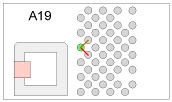
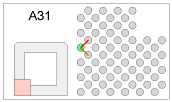
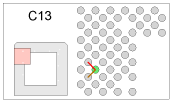
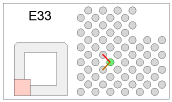
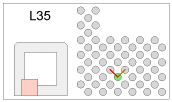
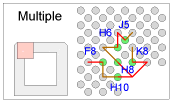
Update: Pins F8, K8, H6, H8, H10 are the SOFTVID pins, which
is how the CPU tells the motherboard to change it's voltage when using PowerNow.
They are marked as N/C in the desktop CPU datasheets, but as SOFTVID in the
mobile datasheets. J5 is still unknown.
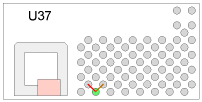
8:38 PM NZDT, 14-NOV-2003
Went shopping and picked up a XP2500 to do experiments on. Stepping is
AQZFA0342UPMU (ie: week 42). So far I've only confirmed that it's locked and
tried a few ways to unlock it. I've tried changing the multiplier through the
dip-switches on my motherboard (failed), and cutting a L3 bridge (failed). My
conductive paint has all dried up, so I'm going to go shopping on Monday to pick
up some more. Then, I'll drag out some wires from the between the L1's and L3's
(where the taps to the CPU come from) and do some voltage measurements while
it's running (and changing the multiplier to see if that affects it). I'm also
going to check to see if enabling SMP through the L5 bridge still works.
Apparently enabling SMP on the Thorton is the same as before the lock was
applied (just reconnect a certain L5 bridge).
Also, the "fake" L3 bridge pins appear to be either not connected or dot
directly tied to the common ground or vcore. Under the microscope, they
definately either dive down to the next level of the PCB or are not connected at
all. Or possibly I just stuffed up the measurements :) I'll be repeating them
again soon.
Now that I've got a bit of time, here's a quick summary of what this is all
about (in case you don't know). All socket-A CPUs have, historically, either
unlocked or not too tricky to unlock. The Thunderbirds had the pencil trick, the
Palominos needed more care, but still relatively easy, and the Thoroughbred and
Barton came unlocked to start off with.
About a week or so ago, reports started to come up of Barton 2500's (the most
commonly used chip for overclocking) that were not responding to multiplier
changes. Initially they were ignored as BIOS problems, but it quickly became
apparent that the problem was the chip itself. They were now multiplier locked.
The first step was to identify the locked chips: currently it looks as though
just about all week 41 or later CPUs are locked, most week 40's are locked, and
some week 39's are locked. Apart from that, noone has found a pattern yet
(though if you submit details to the database, one might be found :) ).
So, what's been tried? The first attempt was the pin-trick, where the pins on
the bottom of the CPU are painted together. Didn't work. Then, L3 bridge
modification was tried. No go for that either. So it appears that the L3
bridges are now unused, at least in the default state of the chip.
Another interesting thing is that there is no visible difference between locked
and unlocked CPUs. There was also a comment somewhere (I can't find it any
more) that someone's locked 2600 had the same bridge configuration as a
locked 2500. This suggests that the real "bridges" are somewhere else on the
PCB. This was a mistake, apparently due to a low-quality picture.
It's unlikely a die change was done as this would involve huge expense by
AMD, though there is a possiblilty that the Barton core was built with the
ability to be die-locked. The most probable option is that the package was
designed with the ability to be locked without using the L3 bridges. This would
either be fuses inside the PCB that were blown, or another layer of bridges
under the top layer of bridges that are also cut using the laser. Either way,
unlocking these systems will be very complicated.
8:58 AM NZDT, 14-NOV-2003
Fixed up the script. Apparently some Thortons have the architecture code AXDC
(instead of the usual AXDA) which was causing a few problems. Thanks to whoever
pointed that out.
The two main OC-Forums threads are:
General stuff and some in-depth material
The mechanics of unlocking ONLY
1:05 AM NZDT, 14-NOV-2003
Uploaded the pages to the server. Hope it works :)
All this is going into a MySQL database, so it should be easyish to do various
comparisons and the like from there. So far, it's only traffic in (look at the
time above ...). Note that this page (and the database stuff) was hacked up in
the space of about 4 hours, so quite posibly has some annoying bugs. Let me know
if this is the case. Email is "michael" at this domain (minus the www of course,
ie: emboss.co.nz)
I'll write some more once I get some sleep ...






